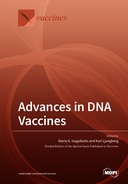Explore

Advances in DNA Vaccines
0 Ungluers have
Faved this Work
Login to Fave
DNA is a rapidly developing vaccine platform for cancer and infectious and non-infectious diseases. Plasmids are used as immunogens to encode proteins to be further synthesized in vaccine recipients. DNA is mainly synthetic, ensuring enhanced expression in the cells of vaccine recipients (mostly mammalians). Their introduction into the host induces antibody and cellular responses. The latter are often more pronounced, and mimic the events occurring in infection, especially viral. There are a few distinct ways in which the vaccine antigen can be processed and presented, which determine the resulting immune response and which can be manipulated. Routinely, the antigen synthesized within the host cell is processed by proteasome, loaded onto, and presented in a complex with MHC I molecules. Processing can be re-routed to the lysosome, or immunogen can be secreted for further presentation in a complex with MHC II. Apart from expression, vaccination efficacy depends on DNA delivery. DNA immunogens are generally administered by intramuscular or intradermal injections, usually followed by electroporation, which enhances delivery 1000-fold. Other techniques are also used, such as noninvasive introduction by biojectors, skin applications with plasters and microneedles/chips, sonication, magnetofection, and even tattooing. An intense debate regarding the pros and cons of different routes of delivery is ongoing. A number of studies have compared the effect of delivery methods at the level of immunogen expression, and the magnitude and specificity of the resulting immune response. According to some, the delivery route determines immunogenic performance; according to others, it can modulate the level of response, but not its specificity or polarity. The progress of research aiming at the optimization of DNA vaccine design, delivery, and immunogenic performance has led to a marked increase in their efficacy in large species and humans. New DNA vaccines for use in the treatment of infectious diseases, cancer, allergies, and autoimmunity are forthcoming. This Special Issue covers various aspects of DNA vaccine development.
This book is included in DOAB.
Why read this book? Have your say.
You must be logged in to comment.
Rights Information
Are you the author or publisher of this work? If so, you can claim it as yours by registering as an Unglue.it rights holder.Downloads
This work has been downloaded 115 times via unglue.it ebook links.
- 115 - pdf (CC BY) at Unglue.it.
Keywords
- adjuvant
- adjuvants
- AIDS
- alphaviruses
- Antibodies
- artificial T-cell antigens
- BCG
- bicistronic
- circovirus
- Clinical Trial
- computer design
- cytolytic
- Cytolytic T Lymphocytes
- DNA
- DNA immunization
- DNA vaccine
- DNA vaccine constructs
- DNA vaccines
- EBNA1
- Ebola virus disease
- enhancer element
- Epidemiology & medical statistics
- Epstein-Barr virus
- flagellin
- formulations
- Gene expression
- HCV
- HCV vaccine
- hepatitis C virus (HCV)
- HIV
- HIV-1
- HTI
- IL-36
- Immune response
- Immune responses
- immunization
- immunogenicity
- in vitro transcribed mRNA
- Influenza
- innate immunity
- intranasal
- latent proteins
- layered RNA/DNA vectors
- Lipid
- LMP1
- LMP2
- medicine
- Medicine: General Issues
- Mesenchymal stem cells (MSC)
- modified MSC
- mRNA vaccine
- myeloid derived suppressor cells (MDSCs)
- n/a
- nonstructural HCV proteins
- Perforin
- plasmid
- plasmid DNA
- protection against tumor challenges and infectious agents
- Public health & preventive medicine
- rBCG
- recombinant particles
- RNA replicons
- T-cell
- Therapeutic vaccine
- tumor regression
- Vaccine
- vaccine delivery
- Zika
Links
DOI: 10.3390/books978-3-0365-0301-1Editions

